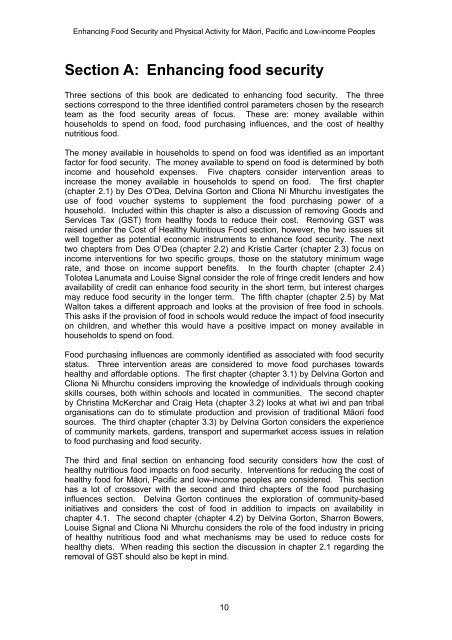enhancing food security and physical activity for maori, pacific and ...
enhancing food security and physical activity for maori, pacific and ...
enhancing food security and physical activity for maori, pacific and ...
- No tags were found...
Create successful ePaper yourself
Turn your PDF publications into a flip-book with our unique Google optimized e-Paper software.
Enhancing Food Security <strong>and</strong> Physical Activity <strong>for</strong> Māori, Pacific <strong>and</strong> Low-income PeoplesSection A: Enhancing <strong>food</strong> <strong>security</strong>Three sections of this book are dedicated to <strong>enhancing</strong> <strong>food</strong> <strong>security</strong>. The threesections correspond to the three identified control parameters chosen by the researchteam as the <strong>food</strong> <strong>security</strong> areas of focus. These are: money available withinhouseholds to spend on <strong>food</strong>, <strong>food</strong> purchasing influences, <strong>and</strong> the cost of healthynutritious <strong>food</strong>.The money available in households to spend on <strong>food</strong> was identified as an importantfactor <strong>for</strong> <strong>food</strong> <strong>security</strong>. The money available to spend on <strong>food</strong> is determined by bothincome <strong>and</strong> household expenses. Five chapters consider intervention areas toincrease the money available in households to spend on <strong>food</strong>. The first chapter(chapter 2.1) by Des O’Dea, Delvina Gorton <strong>and</strong> Cliona Ni Mhurchu investigates theuse of <strong>food</strong> voucher systems to supplement the <strong>food</strong> purchasing power of ahousehold. Included within this chapter is also a discussion of removing Goods <strong>and</strong>Services Tax (GST) from healthy <strong>food</strong>s to reduce their cost. Removing GST wasraised under the Cost of Healthy Nutritious Food section, however, the two issues sitwell together as potential economic instruments to enhance <strong>food</strong> <strong>security</strong>. The nexttwo chapters from Des O’Dea (chapter 2.2) <strong>and</strong> Kristie Carter (chapter 2.3) focus onincome interventions <strong>for</strong> two specific groups, those on the statutory minimum wagerate, <strong>and</strong> those on income support benefits. In the fourth chapter (chapter 2.4)Tolotea Lanumata <strong>and</strong> Louise Signal consider the role of fringe credit lenders <strong>and</strong> howavailability of credit can enhance <strong>food</strong> <strong>security</strong> in the short term, but interest chargesmay reduce <strong>food</strong> <strong>security</strong> in the longer term. The fifth chapter (chapter 2.5) by MatWalton takes a different approach <strong>and</strong> looks at the provision of free <strong>food</strong> in schools.This asks if the provision of <strong>food</strong> in schools would reduce the impact of <strong>food</strong> in<strong>security</strong>on children, <strong>and</strong> whether this would have a positive impact on money available inhouseholds to spend on <strong>food</strong>.Food purchasing influences are commonly identified as associated with <strong>food</strong> <strong>security</strong>status. Three intervention areas are considered to move <strong>food</strong> purchases towardshealthy <strong>and</strong> af<strong>for</strong>dable options. The first chapter (chapter 3.1) by Delvina Gorton <strong>and</strong>Cliona Ni Mhurchu considers improving the knowledge of individuals through cookingskills courses, both within schools <strong>and</strong> located in communities. The second chapterby Christina McKerchar <strong>and</strong> Craig Heta (chapter 3.2) looks at what iwi <strong>and</strong> pan tribalorganisations can do to stimulate production <strong>and</strong> provision of traditional Māori <strong>food</strong>sources. The third chapter (chapter 3.3) by Delvina Gorton considers the experienceof community markets, gardens, transport <strong>and</strong> supermarket access issues in relationto <strong>food</strong> purchasing <strong>and</strong> <strong>food</strong> <strong>security</strong>.The third <strong>and</strong> final section on <strong>enhancing</strong> <strong>food</strong> <strong>security</strong> considers how the cost ofhealthy nutritious <strong>food</strong> impacts on <strong>food</strong> <strong>security</strong>. Interventions <strong>for</strong> reducing the cost ofhealthy <strong>food</strong> <strong>for</strong> Māori, Pacific <strong>and</strong> low-income peoples are considered. This sectionhas a lot of crossover with the second <strong>and</strong> third chapters of the <strong>food</strong> purchasinginfluences section. Delvina Gorton continues the exploration of community-basedinitiatives <strong>and</strong> considers the cost of <strong>food</strong> in addition to impacts on availability inchapter 4.1. The second chapter (chapter 4.2) by Delvina Gorton, Sharron Bowers,Louise Signal <strong>and</strong> Cliona Ni Mhurchu considers the role of the <strong>food</strong> industry in pricingof healthy nutritious <strong>food</strong> <strong>and</strong> what mechanisms may be used to reduce costs <strong>for</strong>healthy diets. When reading this section the discussion in chapter 2.1 regarding theremoval of GST should also be kept in mind.10
















